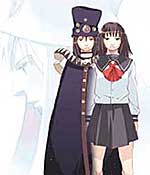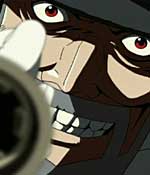
by Sara Ellis and Luis Reyes
More celebrated anime professionals overshadow the work of Sadayuki Murai. Accolades rained down on director Satoshi Kon for "Perfect Blue," but at his base sat Murai's screenplay. The writing for "Cowboy Bebop" propelled chief writer Keiko Nobumoto into the spotlight, but Murai's "Pierrot Le Fou" episode certainly stands out in this consistently well-written series. Kon's new project, "Millennium Actress," again carries a Murai pen credit, though deserved critical acclaim has focused on Kon's deft storytelling rather than the structural dexterity of the script. Murai currently holds a position on the joint Japan/US writing staff for the new "Astro Boy" television series being developed by Sony, but press leaks emphasize the aesthetics of this new version in relation to Tezuka's original creation. If this is any indication on how highly English-speaking audiences regard anime writers, the top result on a Google search for Sadayuki Murai is in French. But Murai's name does pop up on the English language web in connection to the screenplay for "Perfect Blue." He adapted Yoshikazu Takeuchi's novel for Kon's film only two years into his professional writing career, which began when he received a Young Screenwriters Award in an annual competition organized by Fuji TV. Since then his credits have included both live action and anime titles - usually with a supernatural bent - such as "Mokuyou no Kaidan" (Thursday Ghost Stories), a live action mystery, "Toilet no Hanako-san" (Haunted Junction), an animated series about a high school poltergeists, and episode ten of "Eko Eko Azarak," a live action demon hunter tale based on a manga by Koga Shin'ichi. Murai's more recent work includes a writing credit on Go Nagai's "Devilman Lady," and Kohei Kamitono's "Boogiepop wa Warawanai" (Boogiepop Phantom), another ghost story set at a high school. "Perfect Blue," though certainly gory, marks a departure from typical Murai fare in that it deals with psychological violence rather than super-natural violence. "Millennium Actress" virtually eschews violence entirely and allows Murai to create a stirring dramatic text about human longing. Murai's future then may very well be linked to the cinematic whimsy of director Satoshi Kon. For as much as his work engenders extremes, the man himself manifests a soft spoken and self-effacing manner. He's only about thirty years old and extremely gracious. How and when did you become a writer? Sadayuki Murai: I won a screenwriting contest that was held by Fuji Television. That's how a lot of writers get into the business. A long time ago it used to be that aspiring writers would begin their careers by work under a teacher. But that apprentice system is, for obvious reasons, too outdated. So they started a contest. What was your winning screenplay? SM: "The Classroom of Flightless Girls," a drama about a group of high school girls, what happens to them in class etc., a fairly serious type of story. Is your experience mainly based in anime or in other mediums, for example T.V. dramas or feature films? SM: I write for anime, T.V. dramas, movies - a bunch of different mediums. In Japan, it used to be that if you were writer you wrote for everything, dramas, movies, television, anime. Recently the specialties have been taking root and now people are focusing on specific mediums. But there are a few writers like myself who still work in various mediums. Do you have any genres that you prefer? SM: I'm often asked that, but for me character or uniqueness of the script is the most important. I'm far more interested in how the content of a story unfolds rather than a particular medium, which is actually why I am able to write for various mediums. When you wrote the "Pierrot Le Fou" episode of "Cowboy Bebop," what kind of working relationship did you have with Keiko Nobumoto?
SM: Actually, Keiko Nobumoto started her career via the same writing contest. So even though we first met through "Bebop," we were familiar with one another's work and had developed a professional trust in each other. This was very helpful to our working relationship. As far as the roles we took in creating that episode, Nobumoto-san decided the basic theme or subject of each episode. For example, she would say, "This episode will include a clown," or "This episode will be centered around feng shui," or "The rival of the hero will appear in this episode." It was the job of myself and the other writers to expand on those points. Nobumoto-san asked me to create an assassin that would fight with Spike. I then took it from there and expanded on that storyline. "Pierrot Le Fou" has a similarity to the work of Tim Burton, or the style of other "Batman" creators. It's also the title of an old Goddard movie. What were your main influences when writing the episode? SM: Actually this is the first time I've heard that work compared to Tim Burton. In Japan I get asked a lot about Katsuhiro Otomo, the director of "Akira." I wasn't conscious of my similarities to Otomo and was surprised when other people compared us. I chose the title however because the director liked Jean Luc Goddard, and I chose the name Tompu because I'm a fan of Y.M.O. (Ryuichi Sakamoto's band Yellow Magic Orchestra). On Y.M.O.'s first album there's a song called Tompu, an allusion to the title of a Goddard film. In "Pierrot Le Fou," the assassin Tompu is brainwashed. In Japan, this is often compared to the psychological manipulation of "Akira." |

